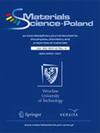Blue/NIR-emitting Phosphor Based on Sr2CeO4: Tm3+, Yb3+ Obtained by Combustion Synthesis
IF 1.1
4区 材料科学
Q3 Engineering
引用次数: 0
Abstract
In this study, pure Sr2CeO4 (SCO) and codoped Sr2CeO4:Tm3+, Yb3+ (SCO:Tm, Yb) of powder phosphors were synthesized by a combustion technique. The concentration of Tm3+ was fixed at 0.5 mol %, while the Yb3+ doping concentration was varied from 0 to 7.0 mol %. The crystalline structure, morphology and luminescence properties were studied using X-ray diffraction (XRD), scanning electron microscope (SEM) and photoluminescence spectroscopy, respectively. The XRD analysis shows the crystalline orthorhombic phase for all synthesized samples of SCO and SCO: Tm, Yb. The SEM results show that the doped sample with 5.0 mol % Yb3+ has the lowest grain particle size of 1.92 mm. The SCO:Tm, Yb phosphors produce mainly blue and near infrared emission bands centered at 481 nm and 813 nm (under 980 nm, excitation) which corresponds respectively to 1G4→3H6 and 3H4→3H6 transitions of Tm3+. In addition, the international commission on illumination CIE coordinates were calculated for all samples taking the range of 400 – 700 nm obtaining for the 5.0 mol % Tm3+ doped sample the coordinates: (x,y) = (0.0833, 0.1671) which match with pure blue color. Due to the strong blue and near infrared emissions, the SCO:Tm, Yb phosphors could be good candidates for use in biomarkers or lighting applications.燃烧合成Sr2CeO4: Tm3+, Yb3+蓝色/ nir发光荧光粉
本研究采用燃烧技术合成了纯Sr2CeO4 (SCO)和共掺杂Sr2CeO4:Tm3+, Yb3+ (SCO:Tm, Yb)粉末荧光粉。Tm3+的掺杂浓度固定在0.5 mol %, Yb3+的掺杂浓度在0 ~ 7.0 mol %之间变化。采用x射线衍射仪(XRD)、扫描电镜(SEM)和光致发光光谱法分别对晶体结构、形貌和发光性能进行了研究。XRD分析表明,合成的SCO和SCO: Tm, Yb均为正交晶相。SEM结果表明,当掺量为5.0 mol %时,Yb3+的晶粒尺寸最小,为1.92 mm;SCO:Tm, Yb荧光粉主要产生以481 nm和813 nm为中心(980 nm激发下)的蓝色和近红外发射带,分别对应于Tm3+的1G4→3H6和3H4→3H6跃迁。此外,计算了400 - 700 nm范围内所有样品的国际照明委员会CIE坐标,得到5.0 mol % Tm3+掺杂样品的坐标为:(x,y) =(0.0833, 0.1671),与纯蓝色相匹配。由于强烈的蓝色和近红外发射,SCO:Tm, Yb荧光粉可能是生物标志物或照明应用的良好候选者。
本文章由计算机程序翻译,如有差异,请以英文原文为准。
求助全文
约1分钟内获得全文
求助全文
来源期刊

Materials Science-Poland
工程技术-材料科学:综合
CiteScore
1.70
自引率
18.20%
发文量
0
审稿时长
6.2 months
期刊介绍:
Material Sciences-Poland is an interdisciplinary journal devoted to experimental research into results on the relationships between structure, processing, properties, technology, and uses of materials. Original research articles and review can be only submitted.
 求助内容:
求助内容: 应助结果提醒方式:
应助结果提醒方式:


